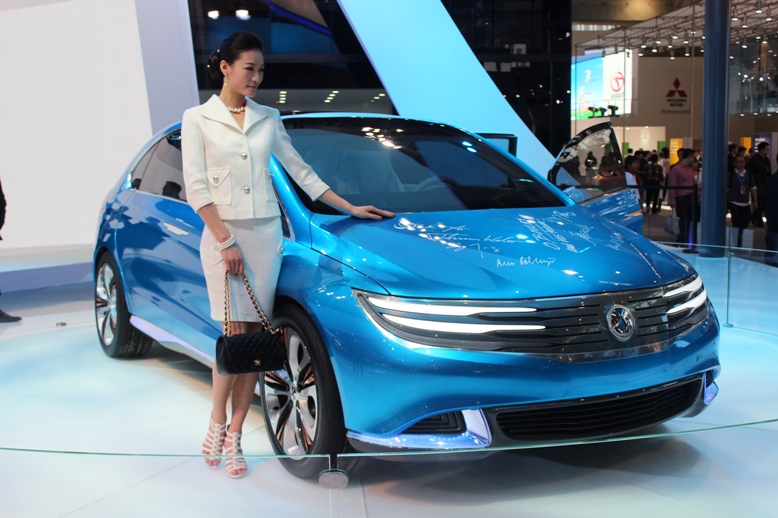Denza, which is set to make its official Malaysian debut very soon, may be a new name for many here, but the brand itself isn’t a fresh face, having been around for close to 15 years. However, all that can be seen presently about the marque is quite far removed from that when the idea for it first surfaced in 2010.
In March that year, BYD Auto and Mercedes-Benz’s parent company Daimler inked a MoU to collaborate on developing and producing electric vehicles for the domestic market, with 50:50 joint venture Shenzhen BYD Daimler New Technology (BDNT) formally established in May 2010 as the chosen vehicle for that expansion into electrification.
Utilising BYD’s battery tech and e-drive systems plus Daimler’s know-how in EV architecture and safety, the Denza nameplate – which roughly translates from Chinese into “rising power and momentum” – for the sub-brand was established in March 2012, a month before the brand’s first outing, a concept previewing the Denza EV, made its debut at Auto China in Beijing.
The Denza EV, featuring a B-Class-based exterior and powertrains lifted from the BYD e6, finally arrived into the market in late 2014, subsequently morphing into the Denza 400 in 2016 and then in 2018 into the Denza 500. Subsequently, the Denza X, a seven-seat SUV based on the second-generation BYD Tang, arrived on the scene in 2019.
However, these offerings never really set the scene alight, with the X being a particularly short-lived model lasting only two years. By 2021, seeing its plan to gain electrified traction in China through the undertaking not quite matching the intent, Daimler began moving out of the frame.
In December that year, it reduced its shareholding in the venture to just 10%, and as a result, a moniker change also came about, with the entity being renamed the Shenzhen Denza New Energy Vehicle Co.
With it now controlling the direction and focus of the brand, BYD could essentially determine how Denza products could shape up the way it wanted them to, and following the restructuring, the brand started to take flight, with the arrival of the Denza D9 MPV in 2022 turning the corner for the brand. Although playing it safe as a product, the D9 proved to be a hit with buyers.
Of course, the growing success achieved with its mainstream brand undeniably offered BYD the means to stretch Denza’s legs. The sub-brand’s presence in the market was expanded with new showrooms, with the Denza network running independently from the main brand.
These, as a quick visit to its Zhuizilin outlet in Shenzhen late last year showed, demarcate themselves through a particular CI, which is undoubtedly aimed at imparting a sense of luxe to the brand in the eyes of buyers. With dark wood tones heavily present throughout the facility, the visual projection has an old world feel to it, quite different to the lighter, more modern approach favoured by most automakers these days.
It works well enough for something like the D9, the environmental scope, perhaps less so when trying to pitch a sportier proposition like the Z9 GT, but whatever the case, it does provide Denza with its own identity, distinct enough from that of BYD. The viewing also offered a glimpse of the CI Malaysian consumers can likely expect to see when the brand makes its way here in the near future.
Keeping pace with the network expansion are new offerings, with the brand – which is now 100% owned by BYD following Mercedes-Benz’s sale of its remaining 10% stake in September last year – adding the Denza N7 crossover to its product portfolio in 2023 and the Denza Z9 GT shooting brake – and sedan – towards the end of 2024.
It also began its right-hand drive programme for the global market in 2024, with the D9 being the first to undergo the conversion process, rolling out from the company’s Changsha plant in August.
While it remains the only RHD Denza model at present, thus becoming the first model to make it to Malaysia when the brand is launched soon, the N7 and Z9 GT are very likely to follow suit eventually, given how the presentations during the Shenzhen visit focused quite heavily on the duo.
Though not mentioned officially, background discussions intimated the possibility that the Fanchengbao Bao 5 (or Leopard 5), which last year was said to be under consideration for Malaysia, could make its way here running under a Denza badge, that thought cemented by developments elsewhere. The off-road SUV was recently spied running trials in Australia, and it was suggested that it could be known as the Denza B5 there, as reported by Drive.
Should that naming convention come about, it would depart from the intended nomenclature the company has suggested for its Denza product lines, which is to start them with the alphabets D, E, N, Z, and A, of which the letters A and E have not been assigned to anything as yet.
The brand recently indicated that it is set to introduce two models in 2025, one of which is said to be an MPV that will be larger – and more powerful – than the D9, CnEVPost reports. The other is the N9 SUV, a “luxury plus” offering that BYD says has been bench-marked against the likes of the BMW X7, Range Rover and Mercedes-Benz GLS.
The 5,258 mm-long offering will sit on BYD’s e3 platform and feature a three-motor (one front, two rear) independent drive set-up, offering nearly 1,000 hp in total output. No indication as to whether it will make it here, but given the way the sub-brand is working at the moment, anything sounds possible.
GALLERY: Denza D9 EV, right-hand drive first-batch production roll-off
Looking to sell your car? Sell it with Carro.











